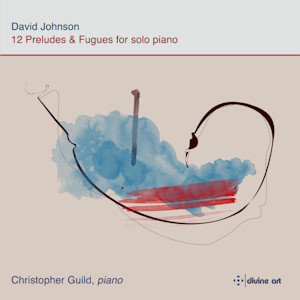
David Johnson (1942-2009)
12 Preludes and Fugues for solo piano
Christopher Guild (piano)
rec. 2023, The Old Granary Studio, Beccles, UK
Divine Art DDX21124 [64]
Dr David Charles Johnson is better known for his contribution to the history of Scottish music, especially in the 18th century. Born in Edinburgh, he came from a musical family. His mother was Director of the Holst Singers of Edinburgh and organist at the historic Rosslyn Chapel. His father was a civil servant and organist at St Columba-by-the-Castle.
I am beholden to pianist Christopher Guild’s detailed analytical liner notes in my preparation of this review.
Johnson’s thesis, Music and Society in Lowland Scotland in the 18th Century (1972), “explores the links between folk and classical music”. Other publications include Scottish Fiddle Music of the 18th Century (1984) and Chamber Music of 18th Century Scotland (2000). His catalogue includes five operas: Thomas the Rhymer; The Cow, the Witch and the Schoolmaster; Building the City; Sorry, False Alarm; and All there was between them. He also wrote for orchestra, trumpet, recorder and voice. He was not only a musicologist and a composer, but a cellist, recorderist, ensemble manager and concert promoter.
According to the liner notes, Johnson’s style was first based on Hindemith and Webern. As he got older, he “wanted to write about ordinary human things”, and “it was clear that extreme atonality and head case construction wouldn’t work for that”. His later music incorporated folk idioms, such as the scales and modes used in folksongs, and more modernist techniques. Recorderist John Turner (The Guardian, 7 May 2009) wrote that Johnson’s compositions are “tonal, concise, and quirky – earthy even. There is often a distinct Scottish flavour, and a hint of pop, and his works are imbued with a concern that his music should be enjoyable for performers and listeners, and socially relevant.”
My listening strategy was simple: one pair at a time, preceded by reading the analysis in the liner notes. There is a danger with programmes like this: concentrated listening may eventually give way to background Muzak. Johnson insisted on a pause at the end of Fugue No.6 in the event of a concert performance of the full set.
Johnson composed this music over three years in the early to middle 1990s. He penned a few pieces in a matter of days, others over an extended period. The set is based on the four-note motif B-H-E-A devised by Aberdonian composer Shaun Dillon (1944-2018); B is German notation for B flat, H for B natural. This is the nearest that one can get in musical notation to the Scots Gaelic word Beatha or Bheatha. It means “life” or, as Johnson elaborated, “welcome, livelihood, food – a positive concept to do with day-to-day survival”. Think of the Scots Gaelic for whisky: uisge beatha (water of life).
The motif is worked up into a 12-note row. Guild writes: “12 Preludes & Fugues is almost like a set of variations, albeit one without the theme being given its own ‘statement movement’ at the start. Each Prelude and Fugue is a quite different exploration on the ‘B-H-E-A’ motif: sometimes the music is in a more pianistically Romantic mode, at other times very jazzy, sometimes neoclassical.” Stylistic pointers would include Prokofiev, Stravinsky, Scottish folk music, jazz and of course Bach.
Several of the pieces allude to music, places or literature. Examples include the Northumberland folksong Bobby Shaftoe in Prelude 5, a transcription of Johnson’s 1974 setting of Scottish poet and political agitator Hugh MacDiarmid’s O Jesu parvule in Prelude 6, and “an affectionate parody of a 17th-century psalm tune, with some deliberately wrong-sounding blue harmonies” in Prelude 8. Then there are, in Prelude 10, bell-like sounds that Johnson describes as “a peaceful Sunday afternoon, in a village in a deep valley with mountains […] Somewhere in the Alps?” The Jacobite song Johnny Cope is “set” in Fugue 11. Most unusual of all, Fugue 10 features an evocation of London Bridge Station, replete with sounds of rumbling train wheels.
The set was dedicated to the pianist and composer Ronald Stevenson (1928-2015). Peter Evans premiered it at the University of Edinburgh’s Reid Concert Hall.
Christopher Guild specialises in the performance of Scottish classical music. His recordings include albums of music by Ronald Stevenson, Francis George Scott, William Beattie Moonie, William Wordsworth, Ronald Center and Bernard van Dieren. This is his first disc for the Divine Art label.
This is a splendid piece of musical archaeology. It may not be everyone’s cup of tea. I suppose that preludes and fugues might be an acquired taste. But David Johnson’s work is creative, interesting and satisfying. Christopher Guild has made another major contribution to Scottish classical music.
John France
To gain a 10% discount, use the link below & the code musicweb10

Contents
Prelude and Fugue No.1 in B flat
Prelude and Fugue No.2 in B
Prelude and Fugue No.3 in E
Prelude and Fugue No.4 in A
Prelude and Fugue No.5 in F sharp
Prelude and Fugue No.6 in G
Prelude and Fugue No.7 in C
Prelude and Fugue No.8 in F
Prelude and Fugue No.9 in D
Prelude and Fugue No.10 in E flat
Prelude No.11 in A flat and Fugue No.11 in G sharp
Prelude No.12 in D flat and Fugue No.12 in C sharp


















